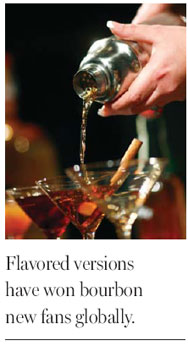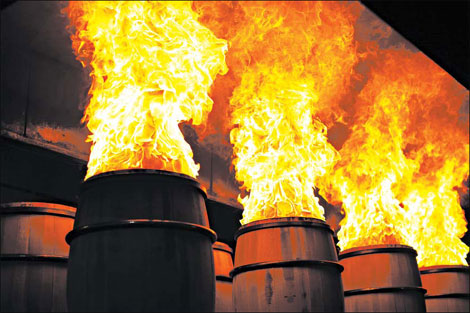All-American spirit takes flight
Updated: 2012-01-15 08:09
By Mickey Meece(The New York Times)
|
|||||||
|
The new hipness of whiskey cocktails has proved a boon to bourbon. Bourbon oak barrels are charred in Kentucky. Photographs by Luke Sharrett for The New York Times |
LOUISVILLE, Kentucky - Bourbon, a singularly American spirit, is undergoing a boom. At a time when many American industries are struggling, distillers here are cashing in on an American renaissance in whiskey-based cocktails, as well as a growing thirst for bourbon around the world.
"Bourbon and rye are now hip among young American trend-setters like we've never seen before," said Charles K. Cowdery, author of "Bourbon, Straight: The Uncut and Unfiltered Story of American Whiskey."
Bourbon is a product America still makes better than anyone else - and, in a way, it always will be. That is because the U.S. Congress decreed in 1964 that "bourbon whiskey is a distinctive product of the United States."
Three elements make bourbon unique: American corn, pure limestone water and new, charred oak barrels.
"It is the people's drink," said Fred Sarkis, a bartender at the Sable Kitchen and Bar in Chicago. "It doesn't get more American than whiskey."
And people not only in the United States but abroad are drinking more of it. Global supplier sales of bourbon and Tennessee whiskey reached $3.8 billion in 2011, versus $3.7 billion in 2010, according to Euromonitor International. (Bourbon is a type of whiskey.)
Distillers are expanding their market with premium small-batch and single-barrel products, along with flavor infusions like honey, cherry and spice. The industry's top five are Jack Daniel's, from Brown-Forman; Jim Beam, from Beam Inc.; Evan Williams, from Heaven Hill Distilleries; Maker's Mark, also from Beam; and Early Times, also from Brown-Forman, according to the 2011 Liquor Handbook.

Jack Daniel's, produced in Lynchburg, Tennessee, takes pride in calling itself Tennessee whiskey. But, just like bourbon, it is made mostly from corn and aged in new charred-oak barrels. The distinctive flavor comes from the "charcoal mellow" process, which involves dropping the whiskey through three meters of sugar maple charcoal.
Dennis Withey of Louisville used to be a big Scotch drinker, but not any more. On a Tuesday night, Mr. Withey and a drinking buddy, Bob Engle, were enjoying a $3 shot of Very Old Barton, chased by beer at the Silver Dollar, a new restaurant and bar. The Barton "was nice and smooth," said Mr. Withey.
Interest in American whiskey has pervaded popular culture in books like "Last Call: The Rise and Fall of Prohibition," by Daniel Okrent; the documentary film "Prohibition," by Ken Burns and Lynn Novick; and the HBO TV series "Boardwalk Empire."
Insiders are excited about the new customers they are attracting with infused flavors like cherry and honey.
Though late to the flavored party, Jack Daniel's had a hit with Tennessee Honey, a 70-proof honey liqueur blended with Old No. 7 Jack Daniel's Whiskey. Michael J. Keyes, North America president for Brown-Forman, said the honey flavor was resonating with African-Americans, Hispanics and women.
"Everybody loves Jack Daniel's brand, but Black Label may not be for them," he said. "This one seems to be accessible to a different demographic."
Jim Beam has found that to be true with its Red Stag Black Cherry bourbon, introduced in 2009. "What it has done is what we thought it would do, which is broaden the audience to bourbon to people who were not bourbon drinkers," said Bill Newlands, Beam's president for North America.
At Brown-Forman, Chris Morris, a master distiller, laid out wood staves like those used to make barrels by hand a few kilometers away at the company-owned cooperage. Aging the distilled spirit in a second barrel is the secret to the new bourbon, Woodford Reserve Double Oaked, he said. "We take a batch of mature Woodford Reserve, reduce the proof to 110 proof and rebarrel in a second brand-new barrel." The barrels are stored for a year, batched together and bottled.
He held up a sample. "Now you get honey, butterscotch notes," he said. Bourbon and Tennessee whiskey account for about 70 percent of the $1.1 billion of distilled American spirits that are exported, according to Frank Coleman of the Distilled Spirits Council of the United States.
Total exports have been thriving for the last decade and were up 17 percent in 2011 through October, over the year-earlier period.
Many distillers in Kentucky have been expanding. The industry is banking on big growth in India and China, Mr. Cowdery said. "If those markets develop as has been anticipated, no one will have made enough. If they don't, everyone will have made too much." Trends, he warned, can change in an instant.
The New York Times
(China Daily 01/15/2012 page11)
